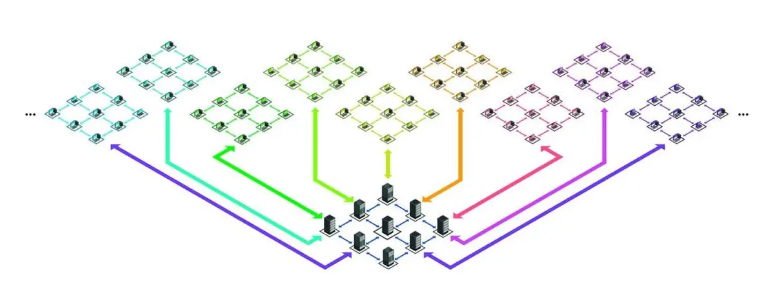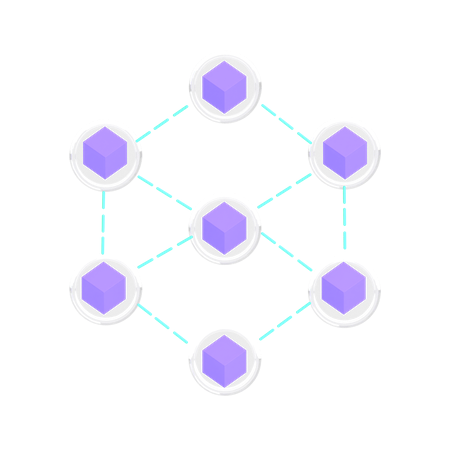Sharding: A Scalability Solution for Blockchain Networks
 Atharv Sunil Bobade
Atharv Sunil Bobade
Introduction
Scalability has been a recurring issue in the blockchain technology field. The demand for effective scaling solutions is growing as the acceptance of cryptocurrencies and decentralized apps (DApps) increases. One promising solution that has gained significant attention is sharding. In this blog post, we will explore the concept of sharding and how it can address the scalability limitations of blockchain networks.
Why do we require Sharding?
Blockchain's Transaction Per Second(TPS) is very low compared to current web2 companies.
Today not many people are using blockchain only a few of the world's population is using it for transactions still we are facing low TPS problem. When more number of people join and do the transactions on the blockchain there might be a very high chance of congestion in the network.
Hence scalability is a very important problem we have to deal with in blockchain technology.
Therefore engineers proposed many solutions to scale blockchain and one of them is Sharding.
The scalability challenge is often referred to as the "blockchain scalability trilemma," which states that it is difficult to simultaneously achieve scalability, security, and decentralization. Blockchain networks typically require consensus mechanisms that involve all participants validating and storing every transaction, resulting in slower transaction processing times and limited scalability.
As the popularity of cryptocurrencies and DApps continues to surge, the need for a scalable solution becomes more pressing. Users expect faster transaction confirmations, lower fees, and a seamless user experience.
What is Sharding?
Sharding is like dividing a big puzzle into smaller pieces to solve it faster. In blockchain, it's a way to make the network work more efficiently. Imagine the blockchain as a long line of transactions. With sharding, we break that line into smaller groups, called shards. Each shard can handle a part of the transactions, like a mini-blockchain. This means we can process multiple shards at the same time, like solving different parts of the puzzle simultaneously. By doing this, we can process transactions faster, improve the overall performance, and make the blockchain more scalable to handle a larger number of users and transactions.
In a sharded blockchain network, each shard operates as an independent chain, maintaining its own transaction history and state. Shards can process transactions and execute smart contracts in parallel, reducing the overall processing time. This approach is particularly beneficial for blockchain networks that experience high transaction volumes, as it alleviates network congestion and enhances the overall efficiency of the system.
However, implementing sharding in blockchain networks also presents challenges. Maintaining consistency and ensuring proper communication and synchronization between shards is crucial. Cross-shard communication and interoperability need to be carefully designed to ensure that transactions involving multiple shards can be executed correctly. Additionally, maintaining security and decentralization becomes more complex in a sharded environment, requiring robust consensus mechanisms and measures to prevent malicious activities.
Sharding has become a hot topic in the blockchain world, and many researchers and developers are exploring its potential. One notable example is Ethereum 2.0, a big upgrade to the Ethereum network. They're using sharding as a key solution to make the network faster and handle more transactions. As sharding technology continues to improve, it's expected to help solve the scalability challenges faced by blockchain networks. This means we can expect more widespread use of decentralized applications on a larger scale, making blockchain even more useful and accessible to everyone.

Sharding Techniques
There are many techniques in sharding let's explore some of the popular techniques.
Network Sharding:- This technique involves dividing the blockchain network into subsets of nodes, known as shards. Each shard is responsible for processing a specific subset of transactions. By distributing the workload across multiple shards, network sharding allows for parallel processing, resulting in increased throughput and reduced transaction confirmation times.
State Sharding:- This technique focuses on partitioning the state or data of the blockchain into smaller parts, with each shard maintaining a portion of the overall state. This approach allows different shards to process transactions related to specific accounts or smart contracts. State sharding can significantly improve the scalability of blockchain networks by distributing the computational load and storage requirements across multiple shards.
Transaction Sharding:- Transaction sharding involves splitting transactions across different shards based on specific criteria, such as account addresses or transaction types.
Hybrid Sharding:- Some blockchain projects combine multiple sharding techniques to achieve optimal scalability. For example, a hybrid approach may involve using network sharding to divide the network into subsets of nodes and state sharding to partition the blockchain's data within each shard. This combination can offer a balance between transaction throughput, storage efficiency, and network resilience.
Sharding and Consensus Mechanisms
Sharding affects how blockchain networks reach an agreement on the state of the blockchain, which is known as consensus. Consensus is important to ensure everyone agrees on which transactions are valid. However, sharding brings challenges to achieving consensus across different parts of the network called shards. To handle transactions that involve multiple shards, it's essential to have efficient communication between them. Protocols need to be designed to make sure that all shards stay consistent and agree on the order of transactions. Consensus algorithms like Proof-of-Work (PoW), Proof-of-Stake (PoS), or Practical Byzantine Fault Tolerance (PBFT) have to be adapted to work in sharded networks. Designing consensus mechanisms for sharded networks involves solving problems like coordinating shards, selecting the right shards, and ensuring security and fairness across all shards. Having a strong consensus that works across shards is crucial for successfully using sharding in blockchain networks.
Conclusion
Sharding offers a promising solution to the scalability problem faced by blockchain networks. By dividing the network into smaller, more manageable parts, sharding enables increased transaction throughput and improved overall performance. However, implementing sharding also poses various challenges related to security, consensus, and decentralization. As blockchain technology continues to evolve, sharding is likely to play a significant role in achieving the scalability necessary for mainstream adoption and the realization of the full potential of decentralized applications.
In the next blog, we will discuss Layer2 in detail and learn about how it can solve the scaling problem.
Thank you for reading this blog it means a lot. I hope you understand Sharding: A Scalability Solution for Blockchain Networks
Feel free to comment your thoughts, suggestions, and what you want me to include. :)
Thank you!
Subscribe to my newsletter
Read articles from Atharv Sunil Bobade directly inside your inbox. Subscribe to the newsletter, and don't miss out.
Written by

Atharv Sunil Bobade
Atharv Sunil Bobade
Working as a Blockchain Developer at @blocktheoryhq A technology enthusiast with a passion for learning Web3 👥 Member @developer_dao
